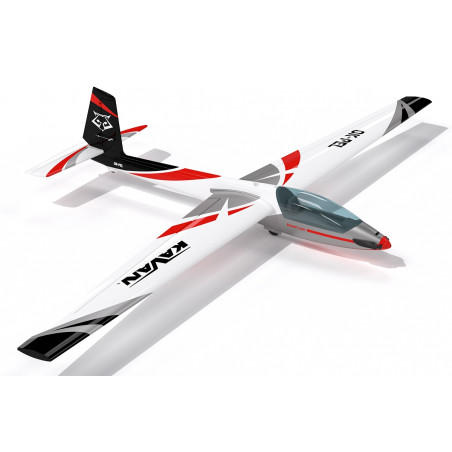


























In the late 1980s, the Polish company Margański & Mysłowski - Zakłady Lotnicze recognized that there was a gap in the market for aerobatic gliders - the good old wooden SZD-21-2b Kobuz 3 built in the 1950s was no longer sufficient for high-performance aerobatics. And so in 1991, designers Edward Marganski and Jerzy Cisowski, supported by Jerzy Makula (then a three-time world aerobatic champion) came up with the new Swift S-1, a modern, all-composite aerobatic glider with an incredible turning speed. (Only 4s) can withstand an overload of +/-10g. The reward came almost immediately - Jerzy Makula won his fourth FAI world aerobatic title that same year.
And now you can enjoy flying a model of this magnificent glider with a span of 2400 mm powered by a powerful AC motor !...
The fuselage is made of highly resistant EPO (extruded polyolefin) foam with thorough internal carbon reinforcements. The model is fitted with a C3548-750 AC electric motor with 11x8" folding propeller and a KAVAN R-50SB regulator with a powerful BEC power stabilizer needed to power the 4 micro servos on board. The cockpit cover is removable, attached with a bolt at the front and fastened with a magnet at the rear. On the bow you will find enough space for the battery and receiver. The direction and altitude rudder servos are located in the keel, the rudders are driven by short straight steel rods.
The wing of the EPO foam model is two-piece with carbon beams, the protruding parts of which also serve as a wing coupling that fits into the duralumin bushings in the fuselage. The wing halves are attached with a plastic screw. The ailerons across the wing span (reinforced with carbon tubes) are controlled independently by two servos with short straight rods.
The tailplane is also made of EPO foam with carbon tube reinforcements. The horizontal surface of the tail is attached to the fuselage with a pair of screws for easy assembly and disassembly.
You will need a 2200-2700 mAh four-cell LiPo with at least 30C capacity to power it. Choose a specific type so that the correct center of gravity position will work best for you without further weighting.
To control the model as a last resort, you can use a four-channel computer RC kit without special features - in the basic design, the ailerons are connected to only one channel via a Y-cable. The ideal, of course, is to use at least a six-channel RC computer set that allows independent control of the ailerons by two servos and their mixing in the role of an airbrake (both ailerons swing up in unison). In this case, you need to replace the Y cable of the ailerons in the fuselage with two (15-30 cm) extension cables. Of course, the manual includes a detailed table with proven default rudder deflection settings (including mixes) to easily prepare the Swift for flight.
The ARF kit includes: finished EPO foam fuselage, wing and tail surfaces with mounted motor, propeller, regulator and 4 GO-17MG servos, instructions.
Technical data: